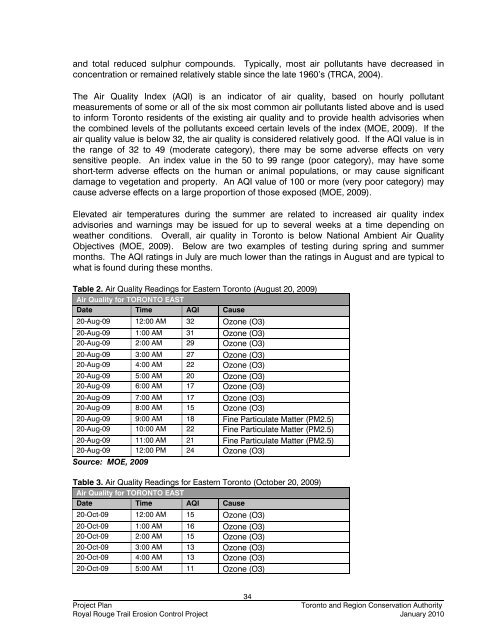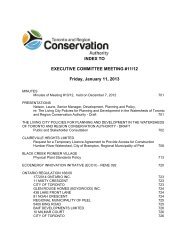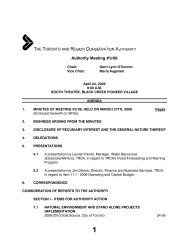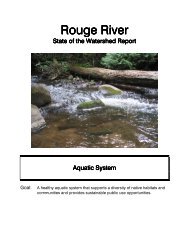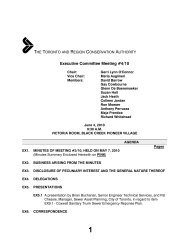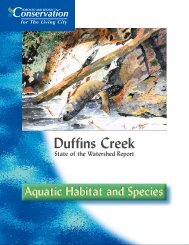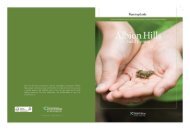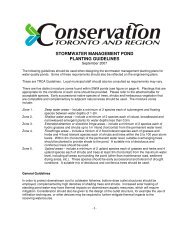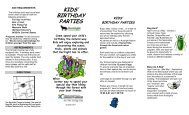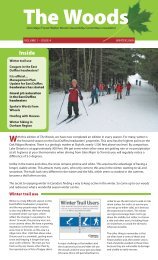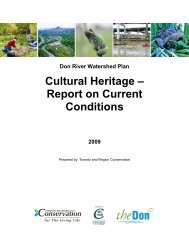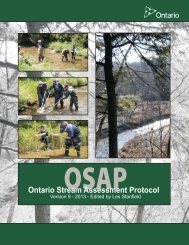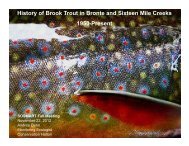Royal Rouge Trail Erosion Control Project - Toronto and Region ...
Royal Rouge Trail Erosion Control Project - Toronto and Region ...
Royal Rouge Trail Erosion Control Project - Toronto and Region ...
You also want an ePaper? Increase the reach of your titles
YUMPU automatically turns print PDFs into web optimized ePapers that Google loves.
<strong>and</strong> total reduced sulphur compounds. Typically, most air pollutants have decreased in<br />
concentration or remained relatively stable since the late 1960’s (TRCA, 2004).<br />
The Air Quality Index (AQI) is an indicator of air quality, based on hourly pollutant<br />
measurements of some or all of the six most common air pollutants listed above <strong>and</strong> is used<br />
to inform <strong>Toronto</strong> residents of the existing air quality <strong>and</strong> to provide health advisories when<br />
the combined levels of the pollutants exceed certain levels of the index (MOE, 2009). If the<br />
air quality value is below 32, the air quality is considered relatively good. If the AQI value is in<br />
the range of 32 to 49 (moderate category), there may be some adverse effects on very<br />
sensitive people. An index value in the 50 to 99 range (poor category), may have some<br />
short-term adverse effects on the human or animal populations, or may cause significant<br />
damage to vegetation <strong>and</strong> property. An AQI value of 100 or more (very poor category) may<br />
cause adverse effects on a large proportion of those exposed (MOE, 2009).<br />
Elevated air temperatures during the summer are related to increased air quality index<br />
advisories <strong>and</strong> warnings may be issued for up to several weeks at a time depending on<br />
weather conditions. Overall, air quality in <strong>Toronto</strong> is below National Ambient Air Quality<br />
Objectives (MOE, 2009). Below are two examples of testing during spring <strong>and</strong> summer<br />
months. The AQI ratings in July are much lower than the ratings in August <strong>and</strong> are typical to<br />
what is found during these months.<br />
Table 2. Air Quality Readings for Eastern <strong>Toronto</strong> (August 20, 2009)<br />
Air Quality for TORONTO EAST<br />
Date Time AQI Cause<br />
20-Aug-09 12:00 AM 32 Ozone (O3)<br />
20-Aug-09 1:00 AM 31 Ozone (O3)<br />
20-Aug-09 2:00 AM 29 Ozone (O3)<br />
20-Aug-09 3:00 AM 27 Ozone (O3)<br />
20-Aug-09 4:00 AM 22 Ozone (O3)<br />
20-Aug-09 5:00 AM 20 Ozone (O3)<br />
20-Aug-09 6:00 AM 17 Ozone (O3)<br />
20-Aug-09 7:00 AM 17 Ozone (O3)<br />
20-Aug-09 8:00 AM 15 Ozone (O3)<br />
20-Aug-09 9:00 AM 18 Fine Particulate Matter (PM2.5)<br />
20-Aug-09 10:00 AM 22 Fine Particulate Matter (PM2.5)<br />
20-Aug-09 11:00 AM 21 Fine Particulate Matter (PM2.5)<br />
20-Aug-09 12:00 PM 24 Ozone (O3)<br />
Source: MOE, 2009<br />
Table 3. Air Quality Readings for Eastern <strong>Toronto</strong> (October 20, 2009)<br />
Air Quality for TORONTO EAST<br />
Date Time AQI Cause<br />
20-Oct-09 12:00 AM 15 Ozone (O3)<br />
20-Oct-09 1:00 AM 16 Ozone (O3)<br />
20-Oct-09 2:00 AM 15 Ozone (O3)<br />
20-Oct-09 3:00 AM 13 Ozone (O3)<br />
20-Oct-09 4:00 AM 13 Ozone (O3)<br />
20-Oct-09 5:00 AM 11 Ozone (O3)<br />
34<br />
<strong>Project</strong> Plan<br />
<strong>Toronto</strong> <strong>and</strong> <strong>Region</strong> Conservation Authority<br />
<strong>Royal</strong> <strong>Rouge</strong> <strong>Trail</strong> <strong>Erosion</strong> <strong>Control</strong> <strong>Project</strong> January 2010


